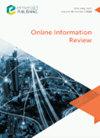Media events in an age of “cross-media”: a smartphone diary app study
IF 3.1
3区 管理学
Q2 COMPUTER SCIENCE, INFORMATION SYSTEMS
引用次数: 0
Abstract
Purpose Aiming to explore how audience consume and produce media events in the digital, distributed and social era we live in, the paper analyzes the viewing patterns of video news items during a media event (the week of Donald Trump's presidential visit to Israel, the first to a country outside the US), compared to a parallel comparable “ordinary” period (two weeks later, in which no inordinacy events occurred). The comparison focused on simultaneous activities of audiences engaged with the event, with either related (i.e. second screening) or unrelated (i.e. media multitasking). Design/methodology/approach The research is a diary study based on a dedicated mobile app in which respondents reported their news-related behavior during two periods: a media event period and comparable “ordinary” period. Findings Participants reported watching significantly more news video items in the first day of the media event week compared to the first day of the “ordinary” week. More than half of the viewing reports of the media event were not on TV. In the media event week, there were significantly higher percentages of viewing reports on smartphones/computers and significantly higher percentages of second-screening reports. Originality/value This is the first study that empirically explores the viewing patterns of video news items during a media event, compared to an “ordinary” period, focusing on media second screening of audiences engaged with the event. This comparison may reveal whether (1) media events still retain their centrality in a multi-screen era and (2) the role of the internet and online social media in the experience of media events.“跨媒体”时代的媒体事件:一项智能手机日记应用研究
目的:为了探索在我们生活的数字、分布式和社交时代,观众是如何消费和生产媒体事件的,本文分析了在媒体事件(唐纳德·特朗普总统访问以色列的那一周,这是第一次访问美国以外的国家)期间视频新闻项目的观看模式,与平行的“普通”时期(两周后,没有发生异常事件)进行比较。比较集中在观众参与事件的同时活动,相关(即第二次放映)或不相关(即媒体多任务处理)。该研究是一项基于专用移动应用程序的日记研究,在该研究中,受访者报告了他们在两个时期的新闻相关行为:媒体事件时期和可比的“普通”时期。与“普通”周的第一天相比,参与者报告在媒体活动周的第一天观看了更多的新闻视频。超过一半的媒体报道没有在电视上播出。在媒体活动周,在智能手机/电脑上观看报道的比例明显更高,二次放映报道的比例也明显更高。独创性/价值这是第一个实证探索媒体活动期间视频新闻的观看模式的研究,与“普通”时期相比,重点关注媒体对参与该事件的观众的第二次筛选。这种比较可以揭示(1)媒体事件在多屏幕时代是否仍然保持其中心地位;(2)互联网和在线社交媒体在媒体事件体验中的作用。
本文章由计算机程序翻译,如有差异,请以英文原文为准。
求助全文
约1分钟内获得全文
求助全文
来源期刊

Online Information Review
工程技术-计算机:信息系统
CiteScore
6.90
自引率
16.10%
发文量
67
审稿时长
6 months
期刊介绍:
The journal provides a multi-disciplinary forum for scholars from a range of fields, including information studies/iSchools, data studies, internet studies, media and communication studies and information systems.
Publishes research on the social, political and ethical aspects of emergent digital information practices and platforms, and welcomes submissions that draw upon critical and socio-technical perspectives in order to address these developments.
Welcomes empirical, conceptual and methodological contributions on any topics relevant to the broad field of digital information and communication, however we are particularly interested in receiving submissions that address emerging issues around the below topics.
Coverage includes (but is not limited to):
•Online communities, social networking and social media, including online political communication; crowdsourcing; positive computing and wellbeing.
•The social drivers and implications of emerging data practices, including open data; big data; data journeys and flows; and research data management.
•Digital transformations including organisations’ use of information technologies (e.g. Internet of Things and digitisation of user experience) to improve economic and social welfare, health and wellbeing, and protect the environment.
•Developments in digital scholarship and the production and use of scholarly content.
•Online and digital research methods, including their ethical aspects.
 求助内容:
求助内容: 应助结果提醒方式:
应助结果提醒方式:


